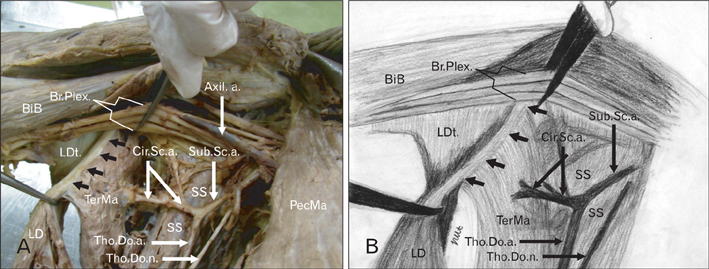Anat Cell Biol.
2012 Sep;45(3):211-213. 10.5115/acb.2012.45.3.211.
Variant insertion of the teres major muscle
- Affiliations
-
- 1Department of Anatomy, Faculty of Medicine, Khon Kaen University, Khon Kaen, Thailand. iamsaard_sitt@yahoo.com
- 2Integrative Complementary Alternative Medicine (ICAM) Research and Development Group, Faculty of Medicine, Khon Kaen University, Khon Kaen, Thailand.
- KMID: 2046750
- DOI: http://doi.org/10.5115/acb.2012.45.3.211
Abstract
- The teres major (TerMa) muscle has a clinical significance for tendon transfer procedures in patients with massive rotator cuff tears. Individually, it originates from the dorsum of the inferior angle of scapula and inserts into the medial lip of bicepital groove of the humerus. Functionally, TerMa in cooperation with latissimus dorsi (LD) adducts arm, medially rotates arm, and assists in arm extension. The variation of TerMa insertion is very rare. In the shoulder and axillary regions of a 33-year-old Thai male cadaver, the variant insertion of the right TerMa was found. The muscle fibers of TerMa are directly attached at the supero-medial border of LD tendon. Notably, there was no terminal tendon of TerMa. To explain an unusual movement of the arm, this rare variation of the TerMa insertion is necessary to be recognized. This case report is very important for surgeons to preoperatively consider using the terminal tendon of TerMa for tendon transfer in treating patients with irreparable cuff tears.
Keyword
MeSH Terms
Figure
Reference
-
1. Costouros JG, Espinosa N, Schmid MR, Gerber C. Teres minor integrity predicts outcome of latissimus dorsi tendon transfer for irreparable rotator cuff tears. J Shoulder Elbow Surg. 2007. 16:727–734.2. Steenbrink F, Nelissen RG, Meskers CG, van de Sande MA, Rozing PM, de Groot JH. Teres major muscle activation relates to clinical outcome in tendon transfer surgery. Clin Biomech (Bristol, Avon). 2010. 25:187–193.3. Boileau P, Chuinard C, Roussanne Y, Neyton L, Trojani C. Modified latissimus dorsi and teres major transfer through a single delto-pectoral approach for external rotation deficit of the shoulder: as an isolated procedure or with a reverse arthroplasty. J Shoulder Elbow Surg. 2007. 16:671–682.4. Pearle AD, Kelly BT, Voos JE, Chehab EL, Warren RF. Surgical technique and anatomic study of latissimus dorsi and teres major transfers. J Bone Joint Surg Am. 2006. 88:1524–1531.5. Routman HD. Tendon transfers about the shoulder. Curr Orthop Pract. 2010. 21:453–461.6. Standring S. Anatomy: the anatomical basis of clinical practice. 2008. 40th ed. New York: Churchill Livingstone.7. Goldberg BA, Elhassan B, Marciniak S, Dunn JH. Surgical anatomy of latissimus dorsi muscle in transfers about the shoulder. Am J Orthop (Belle Mead NJ). 2009. 38:E64–E67.8. Irlenbusch U, Bracht M, Gansen HK, Lorenz U, Thiel J. Latissimus dorsi transfer for irreparable rotator cuff tears: a longitudinal study. J Shoulder Elbow Surg. 2008. 17:527–534.
- Full Text Links
- Actions
-
Cited
- CITED
-
- Close
- Share
- Similar articles
-
- Intramuscular neural distribution of the teres minor muscle using Sihler’s stain: application to botulinum neurotoxin injection
- Topographic Anatomy of the Median Nerve and the Pronator Teres and the Flexor Digitorum Superficialis Muscles
- Isolated Injury of the Axillary Nerve Branch to Teres Minor Muscle Following After Traumatic Posterior Instability of Shoulder
- Ligamentum Teres Injury: Anatomy, Biomechanics, Diagnosis and Treatment
- Variant pectoralis minor muscle: a case study with clinical relevance


